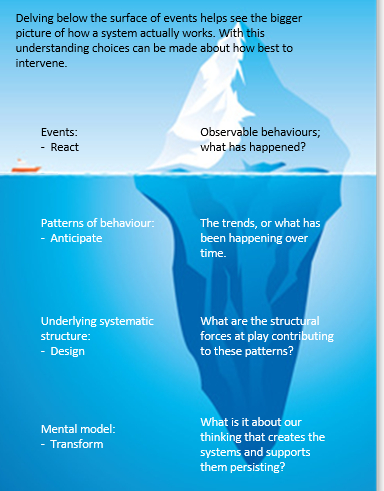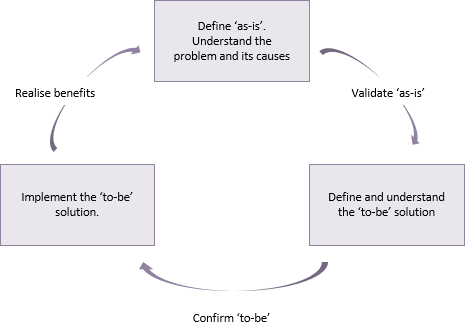Systems thinking is an approach to understanding complex systems. As a project or programme’s scope becomes more complex systems thinking becomes more and more important in order to understand the scope.
There are many definitions of systems thinking. The UK's Open University defines it in the following way:
Systems thinking enables you to grasp and manage situations of complexity and uncertainty in which there are no simple answers. It’s a way of learning your way to effective action by looking at connected wholes rather than separate parts.

A good way to visualise the components of systems thinking is the iceberg metaphor. When looking at a system, it is the events that are visible. If there are problems, these are symptoms not causes.
Current events are the latest manifestations of patterns of behaviour. Understanding these patterns over time enables forecasts to be made and hypotheses to be developed and tested.
Behavioural patterns are, in turn, the result of an underlying systematic structure, which causes the patterns to exist.
Systematic structures function the way they do as a result of the attitudes, values and beliefs of the people within the structure. As Senge1 pointed out: “The deepest insight comes when [people] realise that their problems and their hopes for improvement are inextricably tied to how they think.”
When a project or programme is seeking to achieve benefits through organisational change, it is pointless and damaging to focus on events. Although events will be the manifestation of the beneficial change, they can only be achieved by transforming mental models and designing a new systematic culture. This should create new patterns of behaviour that will allow us to anticipate the type of events we require.
In project and programme terms, we would have a vision for what we want to achieve at a high level. The identification and definition processes would focus on defining and validating the ‘as-is’ situation and then designing the ‘to-be’ situation which would be documented in a blueprint.
The transformed mental models, systemic structures and behavioural patterns are outcomes that lead to the benefits (events). The business case will be constructed by valuing the benefits and judging the cost of achieving the necessary outcomes. All facilitated by tools and techniques such as causal loop diagram and actor maps within a systems thinking framework.
The generic systems thinking process shown below is taken from a white paper developed by a joint working group of the APM’s Systems Thinking SIG and INCOSEUK2.

-
SENGE, P M (1990) The Fifth Discipline: Art and Practice of the Learning Organization, New York, Doubleday.
- Systems thinking for portfolio, programme and project managers, version 1, 16th July 2018, APM & INCOSE UK





